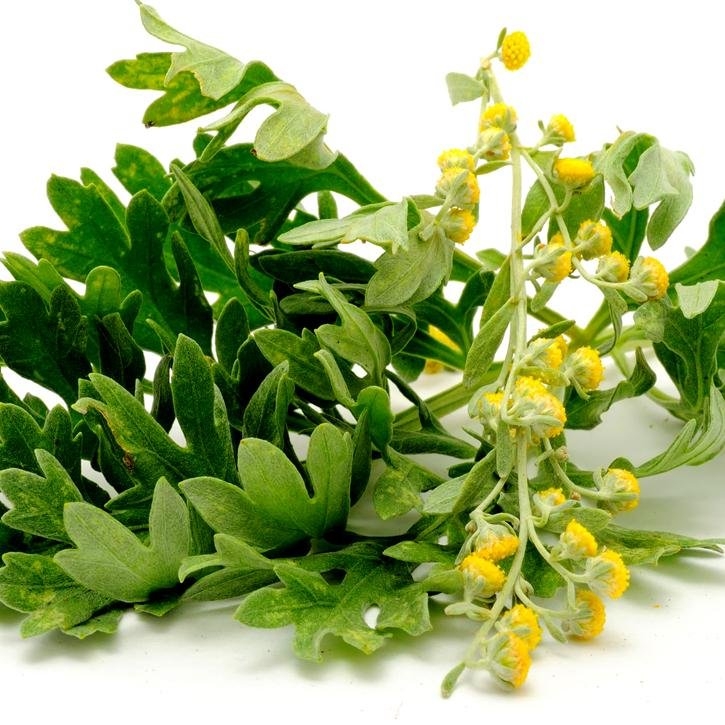Artemisia annua L., belonging to the genus Artemisia, stands out among the approximately 400 species of this genus, known for its aromatic herbs and shrubs. Popularly called sweet wormwood or Chinese wormwood, it is a medicinal plant belonging to the Asteraceae family. It is native to Asia, specifically China. Its historical relevance in traditional Chinese medicine dates back almost 2,000 years, being traditionally used in the treatment of malaria. Known as qinghaosu in Asia and sweet wormwood in the West, it has been a fundamental source of artemisinin, the parent compound of antimalarial drugs. In Chinese herbal medicine, the aerial parts of the plant are used to treat infectious diarrhea, fever and intestinal parasites.
A. annua is described as a shrub of the family Asteraceae (formerly Compositae), with variable heights from 30 to 250 cm. Its tower-like architecture is composed of cylindrical stems and branches 30 to 80 cm long, with bipinnate, glabrous leaves covered with dense glandular hairs. The terminal panicle inflorescences exhibit small yellow flowers, with wide bracts and a gray ovoid fruit of approximately 0.5 mm.
Among its various active principles is artemisinin (sesquiterpene lactone, present in greater proportion in the aerial part of the plant), with proven action in human patients against malaria. It should be noted that the dried leaf of A. annua was effective in cases resistant to treatment with i.v. artemisinin and artesunate-based combination therapies.
Probably, flavonoids and other constituents of the drug potentiate the efficacy of artemisinin. Both artemisinin and the leaf and seed n-hexane fractions of A. annua have shown significant inhibitory activity against both promastigotes and intracellular amastigotes of Leishmania donovani.
Aerial part of the plant (flowers, leaves and stem) and seed.
Aerial part
Seeds
If there is an allergy to plants of the Asteraceae family, to which Artemisia annua belongs.
Not described in the recommended doses.
Tejada R, Iniesta V. (2021) Evaluación de la eficacia de un extracto de Artemisia annua en leishmaniosis canina. Revista de Fitoterapia 2021; 19 (1): 43-60.
Botánica, biología, composición química y propiedades farmacológicas de Artemisia annua L.Revista Cubana de Plantas Medicinales, versión On-line ISSN 1028-4796, Volumen 14, Número 4, Ciudad de La Habana, octubre-diciembre de 2009.Lérida Acosta de la Luz; Ricardo Castro Armas
Solano-Gallego L, Miró G, Koutinas A, Cardoso L, Pennisi M, Ferrer L, et al. LeishVet guidelines for the practical managementof canine leishmaniosis. Parasites & Vectors 2011; 4: 86. Disponible en http://www.parasitesandvectors.com/content/4/1/86. Consul¬tada: 17:11/2020.
Nsengiyumva Bati Daddy, Luc Malemo Kalisya, Pascal Gisenya Bagire, Robert L. Watt, Melissa J. Towler, Pamela J. Weathers. Ar¬temisia annua dried leaf tablets treated malaria resistant to ACT and i.v. artesunate: Case reports. Phytomedicine 2107; 32: 37-40. Disponible en. https://doi.org/10.1016/j.phymed.2017.04.006 Consultado: 17/11/2020.
Islamuddin M, Chouhan G, Tyagi M, Abdin MZ, Sahal D, Afrin F. Leishmanicidal activities of Artemisia annua leaf essential oil aga¬inst visceral leishmaniasis. Front Microbiol. 2014; 5: 626. Erratum in: Front Microbiol. 2015; 6: 1015.
Islamuddin M, Chouhan G, Farooque A, Dwarakanath BS, Sahal D, Afrin F. Th1-Biased immunomodulation and therapeutic poten¬tial of Artemisia annua in murine visceral leishmaniasis. Tropical Diseases 2015; 9 (1): e3321. Disponible en: http://www.ncbi.nlm. nih.gov/pmc/articles/PMC4287499/. Consultada: 17/11/2020.
Islamuddin M, Farooque A, Dwarakanath BS, Sahal D, Afrin F. Extracts of Artemisia annua leaves and seeds mediate program¬med cell death in Leishmania donovani. J Med Microbiol; 61 (Pt 12): 1709-18.
Islamuddin M, Chouhan G, Tyagi M, Abdin MZ, Sahal D, Afrin F. Leishmanicidal activities of Artemisia annua leaf essential oil against Visceral Leishmaniasis. Front Microbiol. 2014 Nov 25;5:626. doi: 10.3389/fmicb.2014.00626. Erratum in: Front Microbiol. 2015;6:1015. PMID: 25505453; PMCID: PMC4243575.
Islamuddin M, Farooque A, Dwarakanath BS, Sahal D, Afrin F. Extracts of Artemisia annua leaves and seeds mediate programmed cell death in Leishmania donovani. J Med Microbiol. 2012 Dec;61(Pt 12):1709-1718. doi: 10.1099/jmm.0.049387-0. Epub 2012 Sep 6. PMID: 22956747.
Belinchón-Lorenzo S, Iniesta V, Parejo JC, Fernández-Cotrina J, Muñoz-Madrid R, Soto M, Alonso C, Gómez Nieto LC. Detection of Leishmania infantum kinetoplast minicircle DNA by Real Time PCR in hair of dogs with leishmaniosis. Vet Parasitol 2013; 192 (1-3): 43-50.
Belinchón-Lorenzo S, Parejo JC, Iniesta V, Fernández-Cotrina J, Muñoz-Madrid R, Monroy I, Baz V, Gómez-Luque A, Serrano-Agui¬lera FJ, Barneto JL, Gómez-Nieto LC. First detection of Leishmania kDNA in canine cerumen samples by qPCR. Vet Parasitol. 2016; 228: 65-68.
